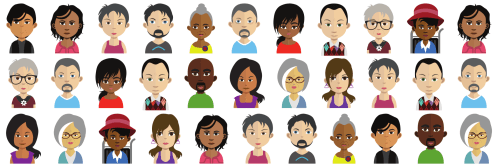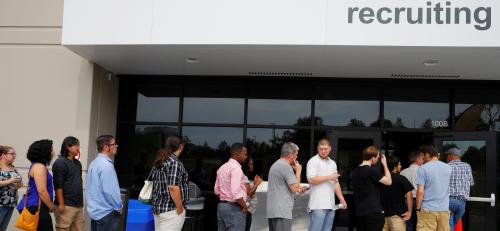The recent report on the out of work population, from Martha Ross and Natalie Holmes, highlights the diversity of people on the sidelines of the labor market. It also shows how the government, philanthropy, nonprofits, training providers, and employers all play a role in helping people prepare for and find jobs.
At Code for America, we’re focused on making sure that the government services intended to play this role actually work. We believe that technology and government are the two biggest levers to improve people’s lives. We envision a government with services that are simple, easy to use, and just as good as the consumer services readily available today in the private sector. Since 2011, Code for America has worked with thousands of tech industry professionals to help hundreds of local governments take a user-centered, iterative, and data-driven approach to solving problems, improving outcomes, and saving money.
Code for America has spent the last two years going deep into the public workforce system, large portions of which are overseen by the U.S. Department of Labor’s Employment and Training Administration and governed by the Workforce Innovation and Opportunity Act (WIOA). This system invests about $4.3 billion annually in job training, placement, and counseling services across the country, which are delivered primarily through a network of 550 regional workforce boards that oversee about 2,500 job centers.
Code for America’s approach to improving these and other systems borrows from the leading practices of agile software development. One critical practice is to start with the end-users in mind: how do they navigate the system, and what do they want to accomplish? That means Code for America staff observe users and talk directly with them and the front-line staff with whom they interact every day. We’ve observed two consistent themes: 1) job seekers are eager to get back to work, but face multiple barriers to securing employment; and 2) front-line staff are dedicated to helping people secure employment.
To develop more user-centered workforce system technology, we examine two “how might we…” questions:
- How might we embed within workforce technology the most successful practices that help people find and keep work? The ways people look for work have changed drastically over the last decade or two. For example, we know that networks help you find a job. It’s about who you know, and who those people know. The tools the public workforce system utilizes simply don’t have the functionality to connect with peers and colleagues or digitize people’s networks, greatly limiting their effectiveness in actually helping someone land a job. Additionally, since industries and the occupations within them are rapidly evolving, a person’s next job may have a different title and come from a different industry than their previous one. We need better tools to help job seekers assess their transferable skills and quickly help them acquire the additional skills they’ll need for their next job. This is especially important in moving toward a labor market based on competency and skills, rather than one based on degrees and pedigree.
- How might we connect job seekers to the public programs that will increase the likelihood of success in their job search? Many of the people profiled in the Meet the Out-of-Work report face barriers to employment, such as low levels of education and difficulties paying for the transportation and child care costs associated with employment. These job seekers would benefit from connecting to other public benefits, such as SNAP, TANF, Medicaid, WIC, rental assistance, childcare assistance, and subsidized transportation. These benefits may in fact improve their ability to search for and keep a job. Today’s workforce system does not have the tools it needs to seamlessly enroll clients in the other public programs that would likely make their job search efforts more successful. Improved policy guidance may help with this, but online services offered by the public workforce system must better navigate job seekers to complementary resources.
Workforce technology systems were not particularly designed with job seekers and employers in mind, which has led to many of the issues listed above. Rather, they were developed to analyze and report data for performance reports, and to show compliance with WIOA’s requirements. The goals of effective user-centric service delivery and seamless reporting and analytics are not inherently incompatible, but a focus on the latter too often undermines the former.
We can devise a more flexible, user-friendly system built on what we know actually helps people find jobs
We can devise a more flexible, user-friendly system built on what we know actually helps people find jobs—such as connections to support services and more effective online career navigation services—rather than checking the boxes of regulatory compliance. This is a solvable problem, and one we must address if we are committed to improving employment outcomes for out-of-work individuals and achieving the goals of promoting individual opportunity and inclusive national economic growth.
Photo credit: Rawpixel





Commentary
Improving workforce technology tools will help put people back to work
November 6, 2017